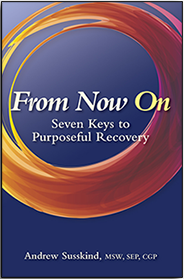Now that you’ve begun to identify examples of narcissistic tendencies, here are some practical steps to consider:
- Distinguish between healthier narcissism and malignant narcissism. Healthier narcissism will generally show up when you’re feeling more emotionally sober, confident and connected to others. Malignant forms of narcissism show up as chronic relationship problems, blaming others and lack of empathy or attunement. Because we all possess each of these qualities, track which qualities are more prevalent and focus your attention on what feels healthier to you.
- Addictive, compulsive behaviors are narcissistic by nature often leaving you in a bubble segregated from others. Show self-compassion to the narcissistic part of yourself by recognizing it as a universal part of the human condition. We all have a different version of it—some more extreme and some more subtle. Give yourself a break and learn about narcissism as part of you—not something that defines you.
- Move from self-centeredness to other-centeredness by distinguishing between the two. Observe yourself as a constant balance between giving and receiving. Practice other-centeredness by giving to others and to your community.
- Consider volunteering which comes in many shapes and forms. For instance, you have friends who can’t afford a dogsitter for the weekend. Volunteer to look after their dog which can be helpful to them but also an exercise in receiving unconditional love from this furry friend.
- Full-blown narcissism and love cannot co-exist. If you find yourself reading this article and getting in touch with a level of loneliness, start small. Consider adopting a pet or planting a home garden. Notice and surround yourself with emotionally-dependable people—one-by-one. The opposite of narcissism is deeper connection.
- Cultivate your generosity of spirit. Keep your eyes and ears open for ways to give back to others. Hold the door open for someone. Donate to your favorite charity. Be respectful of others in all walks of life. A simple way of giving is to say hello or smile at your neighbors.
- Entitlement and envy are ways of protecting yourself from being hurt. Identify feelings of entitlement or envy and take contrary action. For instance, if you are feeling entitled to something right away, practice patience. If you are noticing envy, try to be happy for the object of your envy rather than competitive.
- Depending on the extent of your past narcissistic wounds, intimacy will be a challenge. Begin to notice when you are feeling vulnerable. Go slow. Pace yourself and try to take bite-size emotional risks. As a result, you’ll create more depth to your relationships. Consider joining a therapy group which is one of the best ways to build relationship muscle and to practice vulnerability in a safe and productive way.
In summary, narcissism isn’t a bad thing. It’s only problematic when someone is unwilling to look at patterns that get in their way. We all have a narcissistic layer inside of us which can present a challenge and an opportunity to learn about ourselves more deeply. Observe yourself with curiosity and non-judgment and see what you discover.




